Copperhead snakes are one of the most common venomous snakes in North America. They are found throughout the southeastern and northeastern United States (except for southern Georgia and most of Florida). There are five subspecies of copperheads, with most being around 2-3 feet long, about the length of a yardstick. But how big is the largest copperhead ever recorded? Let’s find out!
What are Copperhead Snakes?
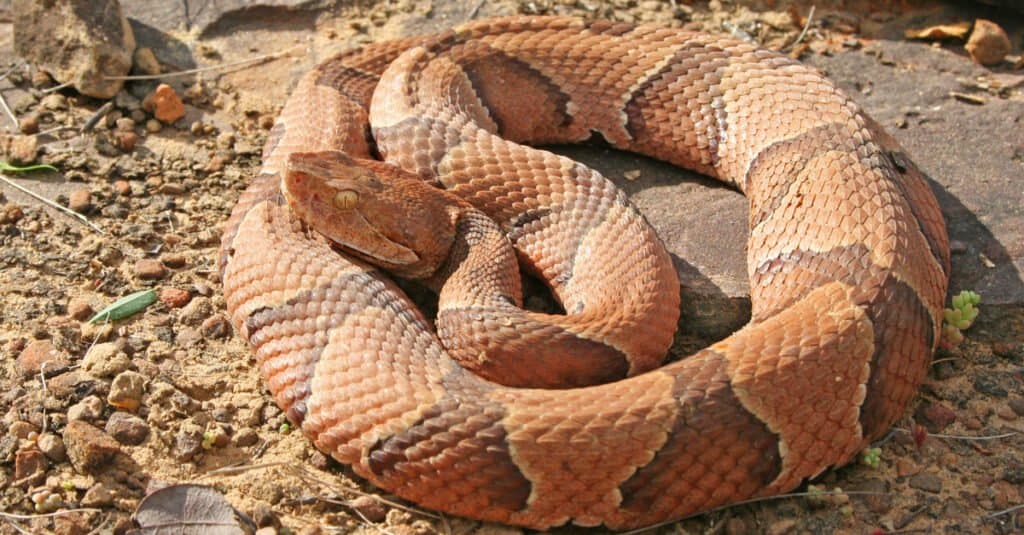
Copperheads have a copper-colored head and tan or copper-colored body with dark brown hourglass markings.
©Creeping Things/Shutterstock.com
Copperhead snakes are among the four main venomous snakes found in the United States. The others are cottonmouths, coral snakes, and a number of rattlesnake species.
Copperheads in North America are broken down into five subspecies with slightly different coloration and markings, but they are all similar in size. You may hear about Australian copperheads and Indian copperheads, but those are unrelated to North American copperheads and refer to the coloration of those snakes.
Copperheads get their name from the copper color of their head, which stands out from their tan to copper base color and dark brown markings. The markings are in an hourglass shape, with the thinnest part of the hourglass along the center of their backs.
Watch the Video on YouTube
Keep reading for all the information!
How Big are Copperheads?
Here is the list of the sizes by subspecies:
Northern: 2-3 feet (24-36 inches)
Southern: 2-3 feet (24-36 inches)
Broad Banded: 1 ½ – 3 feet (20-36 inches)
Trans-Pecos: 1 ½ -3 feet (20-36 inches)
Osage: 1 ½ – 3 feet (20-30 inches)
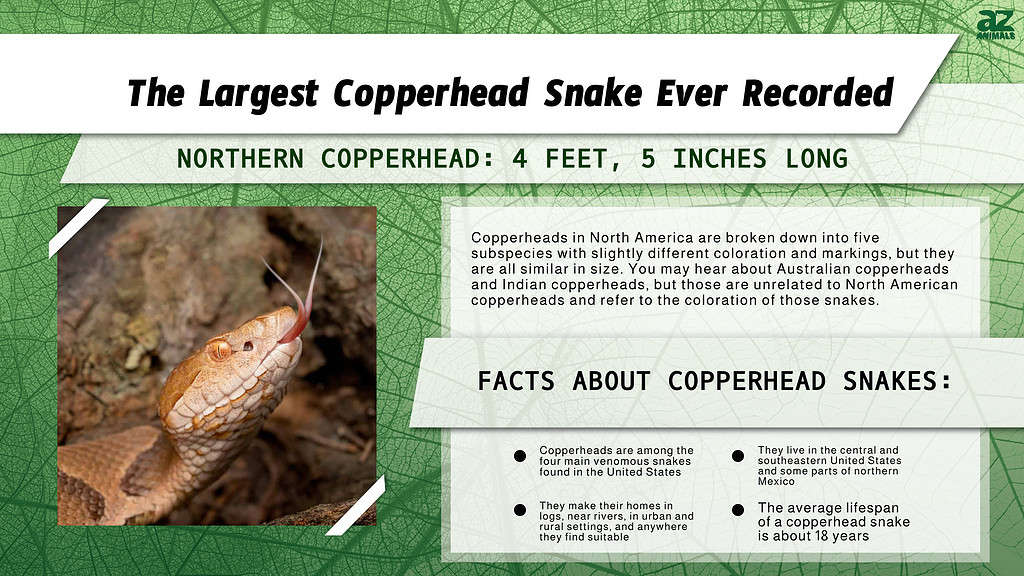
Where do Copperheads Live?
Copperheads live in the central and southeastern United States and some parts of northern Mexico. They do not live on the West Coast or in any of the states on the northern border with Canada.
Northern Copperhead: has the largest range of all the copperheads, overlaps with all the other copperheads, found in central and southern US, as far south as Georgia with some spillover into the panhandle of Florida, north of the southern New England states, and west to Texas and Nebraska.
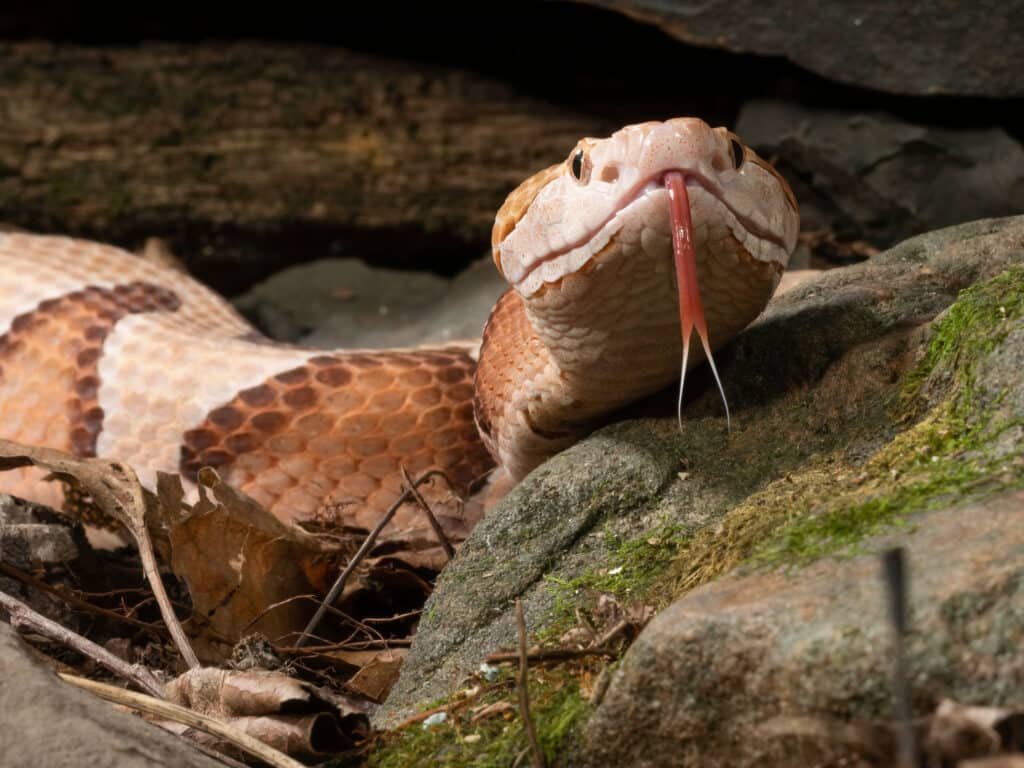
Southern copperheads are found in central and southern U.S.
©Joe McDonald/Shutterstock.com
Southern Copperhead: found in central and southern US, as far south as Georgia, north to Massachusetts, and west to Texas. Southern copperheads are typically larger than northern copperheads.
Broad Banded Copperhead: only found along the southern border of Kansas, the southern border of Oklahoma, and central Texas.
Trans-Pecos Copperhead: only found in the far west of Texas (called the Trans-Pecos region) and northeastern Mexico.
Osage Copperhead: only found in the central states, mostly in Missouri and eastern Kansas.
A photo of a very large copperhead was posted on Facebook with the story of a man, Chase Curtis, who found two copperheads behind his house. One of the snakes got away to hide under a woodpile, but he killed the other one and displayed it for all to see. It measured 40 inches long (3 feet, 4 inches). However, that is not the largest copperhead ever recorded.
What is the Largest Copperhead Ever Recorded?
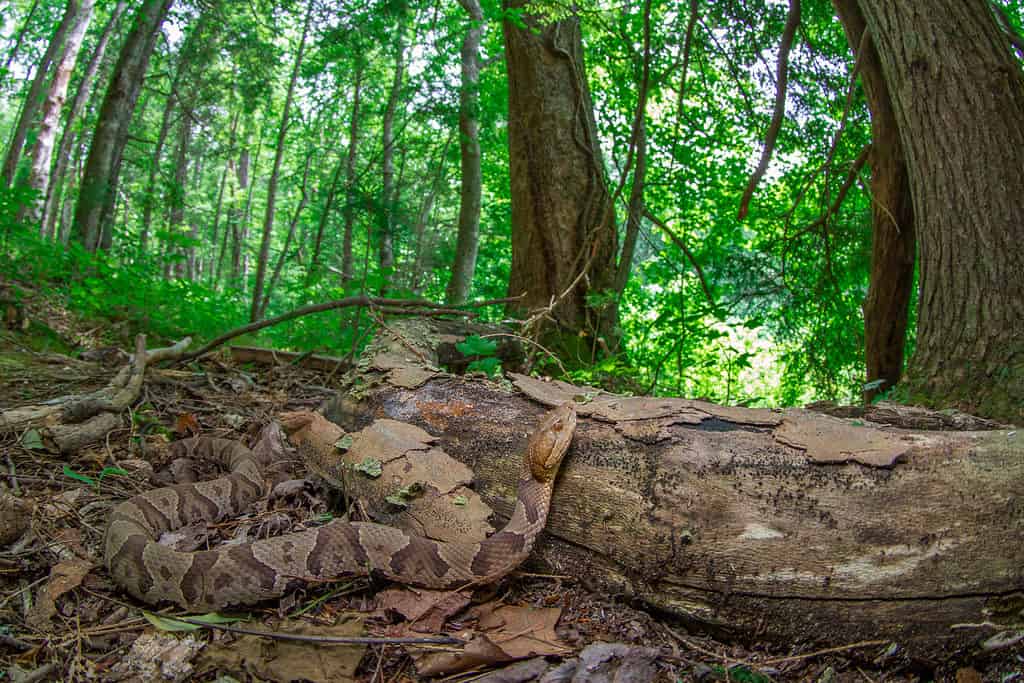
Northern Copperhead Snakes are one of North America’s most common species of venomous snake.
©JacobLoyacano/Shutterstock.com
The largest copperhead ever recorded was 4 feet, 5 inches long! According to the University of Georgia Extention, this is the largest copperhead. This one was a northern copperhead. The largest southern copperhead was recorded at just an inch shorter, at 4 feet and 4 inches long.
How Does That Compare to the Largest Snake in America?
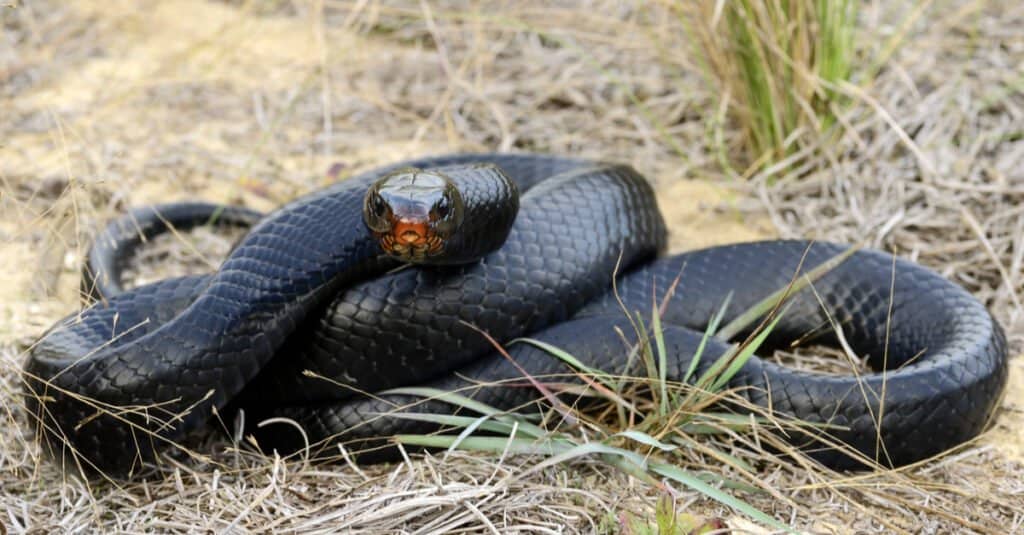
The eastern indigo snake is the longest snake in America, reaching 8 1/2 feet long.
©Patrick K. Campbell/Shutterstock.com
The largest native snake in the United States is the eastern indigo snake. These long blue-black snakes can reach 8 ½ feet long. Obviously, no snake would make a particularly good hockey goalie, but these snakes are wider than a regulation hockey net, which is 72 inches wide!
The largest non-native (invasive) snakes in the United States are the Burmese python and green anaconda. They are listed together because they have a similar story. Both are found only in the southernmost tip of Florida, in the Everglades. While there is a breeding population of Burmese pythons, there are only a very few green anacondas. They are not from here but were accidentally introduced by people who released them as pets or by improperly secured pets escaping. The tropical environment makes a suitable home for these snakes, and without any real predators, Burmese pythons have become a big problem. Let’s take a look at how big they are:
- Burmese Pythons: largest one recorded in the US was 18 feet 10 inches long.
- Green Anacondas: green anacondas are the largest snakes in the world and can reach 18-22 feet long.
What is the Largest Venomous Snake in the United States?
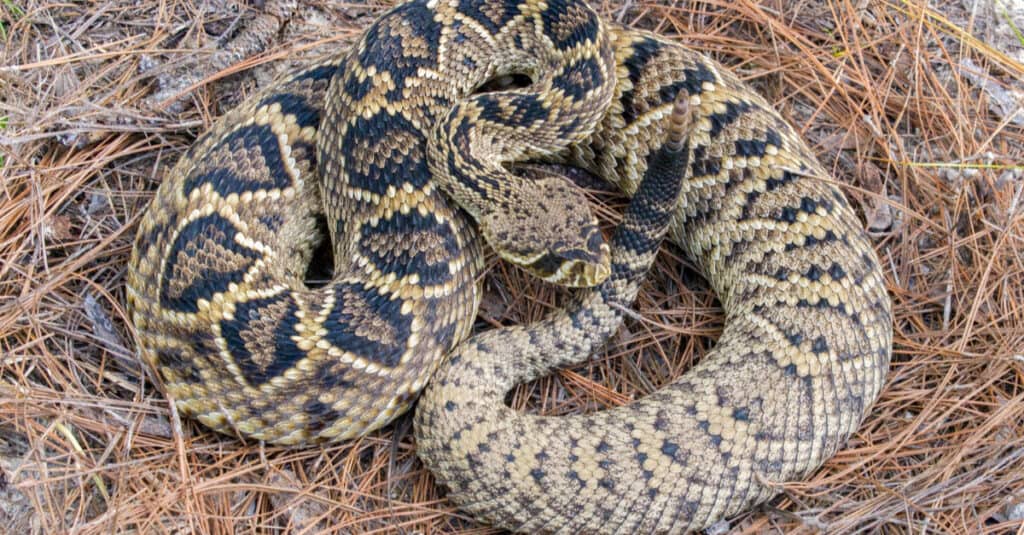
Eastern diamondback rattlesnakes have a pattern that often fades towards their tail.
©Chase D’animulls/Shutterstock.com
The largest venomous snake in the US is the eastern diamondback rattlesnake. These are also one of the most venomous in the US. They can reach 8 feet long!
How Does That Compare to the Largest Snake in the World?
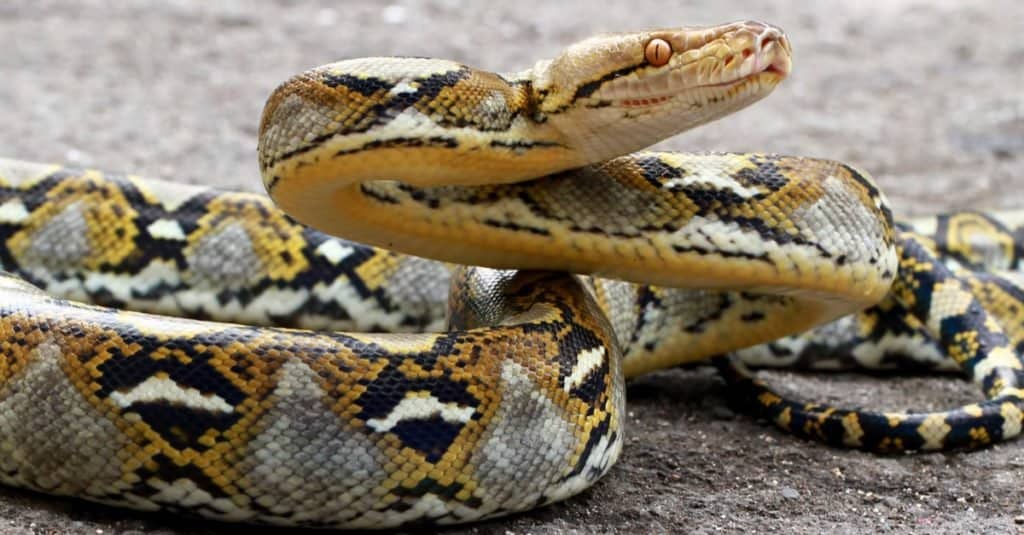
Reticulated pythons are one of the largest snakes in the world.
©Opayaza12/Shutterstock.com
According to the Guinness Book of World Records, the longest snake ever recorded was a reticulated python from Celebes, Indonesia, in 1912. The record still holds. That snake was 32 feet 9 ½ inches long! It would have made a fine soccer goalie with a regulation soccer goal being 24 feet wide.
Copperhead Habitats
Forested, natural areas cover the southeastern and northeastern parts of the United States, creating the perfect environments for copperheads under fallen leaves and other tree debris in the humid climate. These snakes also love large pastures and open fields, also abundant in these regions.
Copperheads make their homes in logs, near rivers, in urban settings, in rural settings, and pretty much anywhere they find suitable. So, if you live in this part of the country, keep an eye out in your wood piles, under tarps, in your garage, and other places where these critters may hide.
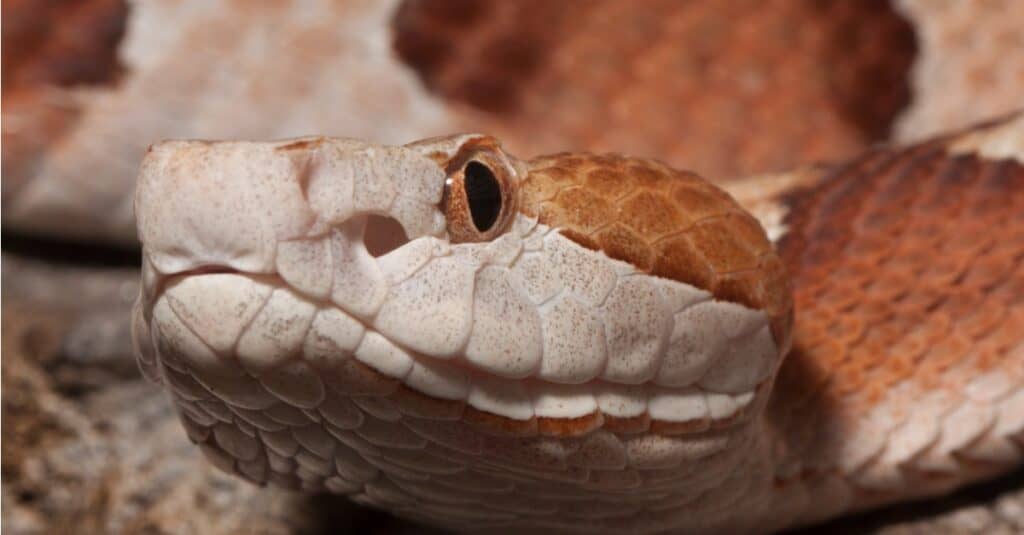
Close-up of venomous Copperhead Snake. Its head, whose color gives the snake its common name, is broad and wedge-shaped.
©iStock.com/Mark Kostich
How Long Do Copperhead Snakes Live?
The average lifespan of a copperhead snake is about 18 years. Young are able to reach sexual maturity after around four years old.
Mating happens during the late spring and early summer months. Copperheads are ovoviviparous, meaning that fertilized eggs develop inside the female and depending on if the snake undergoes hibernation before giving birth.
Copperheads tend to hibernate during the winter in their dens with other snakes, some are even of different species!
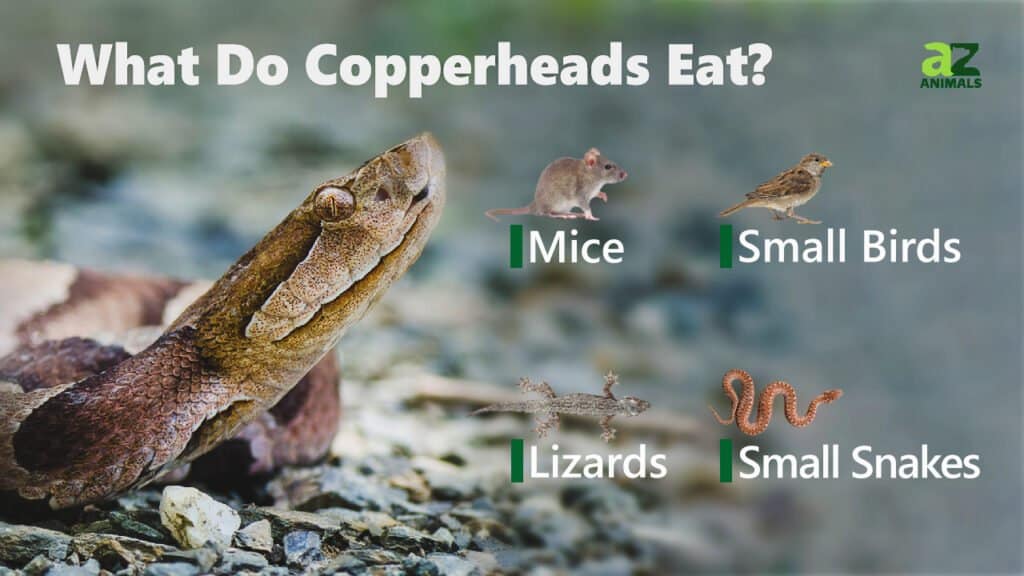
What do Copperhead Snakes eat?
Copperheads are predominately carnivores and are known to eat any animal small enough – including their young. Their diets depend on their environment, but they eat mostly mice, birds, amphibians, and insects. They have also been known to eat cicadas and prairie voles.
Other Record-Breaking Snakes

Coral snakes have distinctive color patterns consisting of black, yellow, and red bands that encircle their bodies.
©Scott Delony/Shutterstock.com
Coral snakes are a type of venomous snake that can be found in different parts of the world, including North and South America. They have distinctive color patterns consisting of black, yellow, and red bands that encircle their bodies. These colors serve as a warning to potential predators about their dangerous nature.
As for the largest coral snake ever recorded, it measured an impressive 47.5 inches long. This record-breaking specimen was discovered in Mexico and belongs to the species known as Micrurus diastema. Compared to other coral snakes, this particular one stood out due to its exceptional size.
Despite their beauty and uniqueness, coral snakes should be approached with caution as they possess potent venom that can cause serious harm if not treated promptly. However, these fascinating creatures play an important role in maintaining ecological balance by controlling rodent populations.
The photo featured at the top of this post is © Breck P. Kent/Shutterstock.com
Discover the "Monster" Snake 5X Bigger than an Anaconda
Every day A-Z Animals sends out some of the most incredible facts in the world from our free newsletter. Want to discover the 10 most beautiful snakes in the world, a "snake island" where you're never more than 3 feet from danger, or a "monster" snake 5X larger than an anaconda? Then sign up right now and you'll start receiving our daily newsletter absolutely free.
Thank you for reading! Have some feedback for us? Contact the AZ Animals editorial team.







